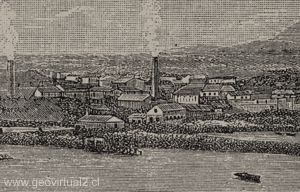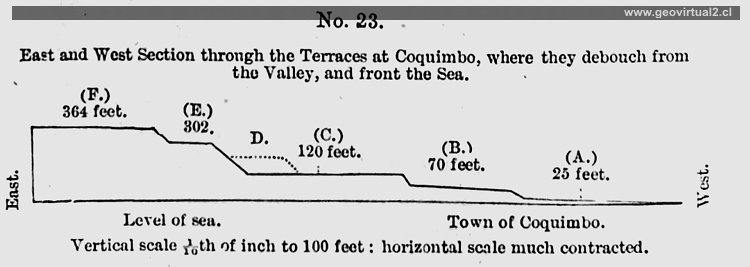Charles Darwin (1835)
Content
Figures
Remarks
Text Darwin
----
Page +

Remarks
Texto extraído de:
DARWIN,
CH. (1876): Geological observations on the volcanic islands and parts of
South America visited during the voyage of H.M.S. Beagle. - 2. Edition,
Smith, Elder & Co.; London.
Página 252 - 254
1 ‘Principles of Geology’ (1st edit.), vol. iii. p. 131.
The original texts were digitized, converted to ASCII and edited by Dr. Wolfgang Griem. Sketches and drawings are digitally cleaned.
Literatura: Charles Darwin
Texto Charles Darwin: Coquimbo
chap. IX. Gravel-Terraces of Coquimbo. p.252-254
Valley of Coquimbo. —
The narrow coast-plain sends, as before stated, an arm, or more
correctly a fringe on both sides, but chiefly on the southern side,
several miles up the valley. These fringes are worn into steps or
terraces, which present a most remarkable appearance, and have been
compared (though not very correctly) by Capt. Basil Hall, to the
parallel roads of Glen Roy in Scotland : their origin has been ably
discussed by Mr. Lyell.1 The first section which I will give, is not
drawn across the valley, but in an east and west line at its mouth,
where the step-formed terraces debouch and present their very gently
inclined surfaces towards the Pacific.
The bottom plain (A) is about a mile in width, and rises quite
insensibly from the beach to a height of twenty-five feet at the foot of
the next plain: it is sandy, and abundantly strewed with shells.
Plain or terrace (B) is of small extent, and is almost concealed by the
houses of the town, as is likewise the escarpment of terrace (C).
On both sides of a ravine, two miles- south of the town, there are two
little terraces, one above the other, evidently corresponding with (B)
and (C); and on them marine remains of the species already enumerated
were plentiful. Terrace (E) is very narrow, but quite distinct and
level; a little southward of the town there were traces of a -terrace
(D) intermediate between (E) and (C). Terrace (F) is part of the
fringe-like plain, which stretches for the eleven miles along the coast;
it is here composed of shingle, and is 100 feet higher than where
composed of calcareous matter. This greater height is obviously due to
the quantity of shingle, which at some former period has been brought
down the great valley of Coquimbo.
Considering the many shells strewed over the terraces (A) (B) and (C),
and a few miles southward on the calcareous plain, which is continuously
united with the upper step-like plain (F), there cannot, I apprehend, be
any doubt, that these six terraces have been formed by the action of the
sea; and that their five escarpments mark so many periods of
comparative rest in the elevatory movement, during which the sea wore
into the land. The elevation between these periods may have been sudden
and on an, average not more than seventy-two feet each time, or it may
have been gradual and insensibly slow. From the shells on the three
lower terraces, and on the upper one, and I may add on the three
gravel-capped terraces at Conchalee, being all littoral and sub-littoral
species, and from the analogical facts given at Valparaiso, and lastly
from the evidence of a slow rising lately or still in progress here, it
appears to me far more probable, that the movement has been slow. The
existence of these successive escarpments, or old clifflines, is in
another respect highly instructive, for they show periods of comparative
rest in the elevatory movement, and of denudation, which would never
even have been suspected from a close examination of many miles of coast
southward of Coquimbo.
---
El texto se digitalizó con OCR, adapción de la
ortografía y gramatica actual.

Figura No. 23. . East and West Section through the Terraces at Coquimbo, where they debouch from the Valley, and front the Sea.
----
Level of sea. Town of Coquimbo.
Vertical scale 1/10-th of inch to 100 feet: horizontal scale much contracted.
Procedure:
The text was scanned (Scanjet HP G3110; converted to ASCII with OCR,
ABBYY fine Reader version 14 and the text was adapted to the current
spelling.

Recorriendo Región Coquimbo
Historia Región Coquimbo
Viaje a Coquimbo (Kunz, 1890)
Earthquake(Gilliss) 1851
Darwin Arquero mine
►
Darwin: Terraces
Hoya Coquimbo Pissis, 1875)
Hoya del Limarí (Pissis, 1875)
Hoya del Choapa (Pissis, 1875)
Ilustración Puerto de Guyacán
Mapa Espinoza (1903)
Mapa de Coquimbo (Stange 1914)
Ferrocarriles Coquimbo
Literatura Región Coquimbo
Indice de lugares y nombres
Relacionado
Ferrocarriles Coquimbo
Línea Tofo
Longitudinal La Calera
Locomotora
La Copiapó
Bibliografía de Atacama


